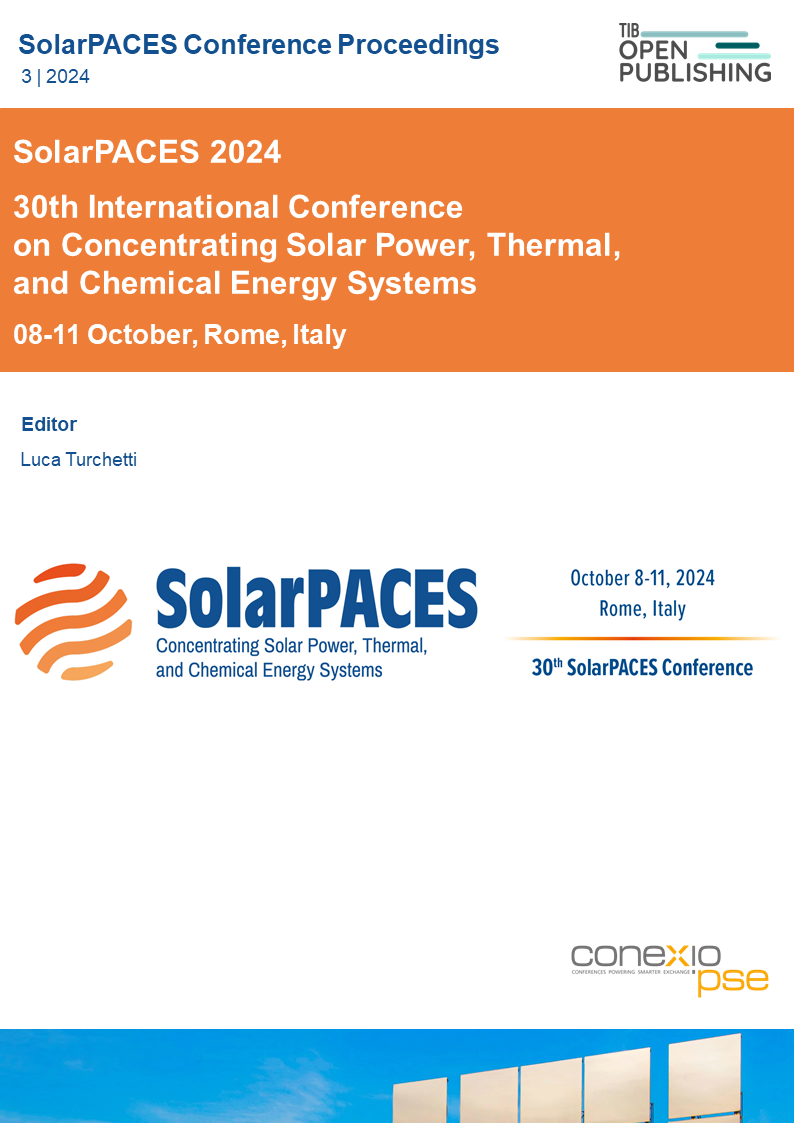Numerical Prediction of the Initial Heating of Granular Material Treatment Using a Solar Rotary Kiln
DOI:
https://doi.org/10.52825/solarpaces.v3i.2345Keywords:
Rotary Kiln, Concentrated Solar Energy, Thermal Energy Storage, Solar Heat Industrial Process;Abstract
Recent studies have proposed rotary kilns as solar receivers or reactors for industrial applications and for thermal storage. However, few investigations have focused on the temperature distribution within the particle bed, which is crucial for understanding system performance and developing optimization strategies. This work presents a comprehensive study of a lab-scale rotary kiln coupled with a high-flux solar simulator, examining the initial seconds of heating inert alumina spheres. Experimental data are compared and integrated with a two-dimensional thermo-fluid dynamic model using an Eulerian continuum approach. The model was initially validated for static particle heating and subsequently applied to simulate a rotating case, predicting temperature distribution in the transversal section of the granular bed. The results demonstrate the significant impact of rotation on homogenizing bed temperature and reducing thermal gradients. When the bed core reaches approximately 180°C, the maximum temperature difference between the center and sides is less than 50°C for the rotating configuration, compared to over 110°C for the static setup. This study provides valuable insights into the thermal behavior of rotary kilns as solar receivers, contributing to the optimization of their design and operation for various industrial and energy storage applications.
Downloads
References
[1] E. Alonso, A. Gallo, M.I. Roldán, C.A. Pérez-Rábago, E. Fuentealba, “Use of rotary kilns for solar thermal applications : Review of developed studies and analysis of their poten-tial”, Sol. Energy. 144 (2017) 90–104. doi:10.1016/j.solener.2017.01.004
[2] M. Neises, S. Tescari, L. de Oliveira, M. Roeb, C. Sattler, B. Wong, “Solar-heated rotary kiln for thermochemical energy storage”, Sol. Energy, 86 (2012) 3040-48. doi: 10.1016/j.solener.2012.07.012
[3] S. Tescari, M. Neises, L. de Oliveira, M. Roeb, C. Sattler, P. Neveu, “Thermal model for the optimization of a solar rotary kiln to be used as high temperature thermochemical re-actor”, Sol. Energy. 95 (2013) 279–289. doi:10.1016/j.solener.2013.06.021
[4] A. Gallo, E. Alonso, C.A. Pérez-Rábago, E. Fuentealba, M.I. Roldán, “A lab-scale rotary kiln for thermal treatment of particulate materials under high concentrated solar radiation: Experimental assessment and transient numerical modeling”, Sol. Energy, 188 (2019) 1013–1030. doi:10.1016/j.solener.2019.07.006
[5] C.K.K. Lun, S.B. Savage, D.J. Jeffrey, N. Chepurniy, “Kinetic theories for granular flow: inelastic particles in Couette flow and slightly inelastic particles in a general flowfield”, J. Fluid Mech. 140 (1984) 223. doi:10.1017/S0022112084000586.
[6] M. Syamlal, W. Rogers, T.J. O`Brien, “MFIX documentation theory guide”, 1993. doi:10.2172/10145548
[7] Beakawi Al-Hashemi, H. M., Baghabra Al-Amoudi, O. S. “A review on the angle of repose of granular materials”. Pow. Tec., 330, (2018) 397–417. doi.org/10.1016/j.powtec.2018.02.003
[8] M.A. Delele, F. Weigler, G. Franke, J. Mellmann, “Studying the solids and fluid flow be-havior in rotary drums based on a multiphase CFD model”, Powder Technol. 292 (2016) 260–271. doi:10.1016/j.powtec.2016.01.026.
Downloads
Published
How to Cite
Conference Proceedings Volume
Section
License
Copyright (c) 2025 Alessandro Gallo, Elisa Alonso Romero, María Isabel Roldán Serrano

This work is licensed under a Creative Commons Attribution 4.0 International License.
Accepted 2025-04-24
Published 2025-10-22
